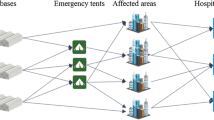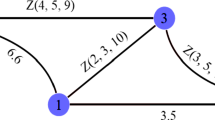Abstract
This research focuses on pre-disaster transportation network protection against uncertain future disasters. Given limited resources, the goal of the central planner is to choose the best set of network components to protect while allowing the network users to follow their own best-perceived routes in any resultant network configuration. This problem is formulated as a two-stage stochastic programming problem with equilibrium constraints, where the objective is to minimize the total expected physical and social losses caused by potential disasters. Developing efficient solution methods for such a problem can be challenging. In this work, we will demonstrate the applicability of progressive hedging-based method for solving large scale stochastic network optimization problems with equilibrium constraints. In the proposed solution procedure, we solve each modified scenario sub-problem as a mathematical program with complementary constraints and then gradually aggregate scenario-dependent solutions to the final optimal solution.


Similar content being viewed by others
Notes
Intel Xeon 3060 CPU @2.40 and 2.39 GHZ, 2 GB RAM.
a GAMS solver for mixed integer nonlinear program problems, http://www.gams.com/solvers/solvers.htm
References
Ban J, Liu H, Ferris MC, Ran B (2006) A general MPCC model and its solution algorithm for continuous network design problem. Math Comput Model 43:493–505
Bell M, Iida Y (1997) Transportation network analysis. Wiley, Hoboken
Cho S, Fan Y, Moore J (2003) Modeling transportation network flows as a simultaneous function of travel demand, network damage, and network level of service. Proceedings of the ASCE Technical Council on Lifeline Earthquake Engineering (TCLEE) Sixth U.S. Conference and Workshop on Lifeline Earthquake Engineering, August 10–13, 2003, Long Beach, CA, pp 868–877
Dafermos S, Nagurney A (1984) On some traffic equilibrium theory paradoxes. Transp Res B 18:101–110
Dantzig GB (1955) Linear programming under uncertainty. Manage Sci 1:197–206
Ferris MC et al (2002) Mathematical programs with equilibrium constraints: automatic reformulation and solution via constrained optimization. Oxford University Computing Laboratory. http://citeseer.ist.psu.edu/633625.html
Hagstrom JN, Abram RA (2001) Characterizing Braess’s Paradox for traffic networks, 2001 IEEE Intelligent Transportation Systems Conference Proceedings, Oakland, California. IEEE, Los Alamitos August
Harker TL, Friesz TL (1984) Bounding the solution of the continuous equilibrium network design problem, Proceedings of the Ninth International Symposium on Transportation and Traffic Theory, Netherlands
Jonsbraten TW, Wets RJ-B, Woodruff DL (1997) A class of stochastic programs with decision dependent random elements, Technical Report. University of California Davis, Davis August
Leblanc LJ, Morlok EK, Pierskalla WP (1975) An efficient approach to solving the road network equilibrium traffic assignment problem. Transp Res 9:309–318 Data available at http://www.bgu.ac.il/~bargera/tntp/
Liu CZ, Fan YY (2007) A two-stage stochastic programming model for transportation network protection, Proceedings of Transportation Research Board Annual Meeting. TRB, Washington, D.C.
Lokketangen A, Woodruff D (1996) Progressive hedging and tabu search applied to mixed integer (0,1) multi-stage stochastic programming. J Heuristics 2:111–128
Luo ZQ, Pang JS, Ralph D (1996) Mathematical programs with equilibrium constraints. Cambridge University Press, Cambridge, UK
Magnanti TL, Wong RT (1984) Network design and transportation planning: models and algorithms. Transp Sci 18:1–55
Marcotte P, Zhu DL (1996) Exact and inexact penalty methods for the generalized bilevel problem. Math Program 74:141–157
Mulvey JM, Vladimirou H (1991) Applying the progressive hedging algorithm to stochastic generalized networks. Ann Oper Res 31:399–424
Mulvey JM, Vladimirou H (1992) Stochastic network programming for financial planning problems. Manage Sci 38(11):1642–1664
Patil G, Ukkusuri S (2007) Stochastic system optimal network design problem. Proceedings of Transportation Research Board Annual Meeting. TRB, Washington, D.C.
Patriksson M, Rockafellar RT (2002) A mathematical model and descent algorithm for bilevel traffic management. Transp Sci 36:271–291
Ralph D, Wright SJ (2004) Some properties of regularization and penalization schemes for MPECs. Optim Methods Softw 19:527–556
Rockafellar RT, Wets RJ-B (1991) Scenarios and policy aggregation in optimization under uncertainty. Math Oper Res 16:119–147
Ruszczynski A (1997) Decomposition methods in stochastic programming. Math Program 79:333–353
Van Slyke RM, Wets RJB (1969) L-shaped programs with applications to optimal control and stochastic linear programming. SIAM J Appl Math 17:638–663
Viswanath K, Peeta S, Salman FS (2004) Investing in the links of stochastic network to minimize expected shortest path length, working paper. Purdue University, Lafayette
Wets RJB (1966) Programming under uncertainty: The equivalent convex program. SIAM J Appl Math 14(1):89–105
Wets RJB (1974) Stochastic programs with fixed recourse: the equivalent deterministic program. SIAM Rev 16:309–339
Woodruff D (2003) Network interdiction and stochastic programming. Kluwer Academic, New York
Yang H, Bell MGH (1998) Models and algorithms for road network design: a review and some new developments. Transp Rev 18:257–278
Acknowledgments
The authors would like to thank National Science Foundation and California Department of Transportation for supporting this research through the Pacific Earthquake Engineering research center. Helpful discussions with Prof. Roger Wets and Prof. David Woodruff at University of California, Davis, and Dr. Jeff Ban at University of California, Berkeley, CA, USA are gratefully acknowledged.
Author information
Authors and Affiliations
Corresponding author
Rights and permissions
About this article
Cite this article
Fan, Y., Liu, C. Solving Stochastic Transportation Network Protection Problems Using the Progressive Hedging-based Method. Netw Spat Econ 10, 193–208 (2010). https://doi.org/10.1007/s11067-008-9062-y
Received:
Accepted:
Published:
Issue Date:
DOI: https://doi.org/10.1007/s11067-008-9062-y




